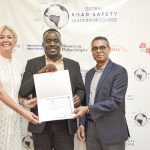Kwale, Kenya – In the quiet mangrove swamps of Majoreni, the sound of waves blends with the soft rustle of mangrove leaves, a once-barren sand flat now transformed into a thriving wetland. It is here that the Kenya Ports Authority (KPA) is celebrating a global win after its “Mangrove Restoration for Ocean Protection and Increased Forest Cover Project” clinched top honours at the 2025 International Association of Ports and Harbors World Ports Conference in Kobe, Japan.

KPA emerged the winner in the Environmental Care category of the prestigious IAPH Sustainability Awards, beating two other finalists from a record-breaking pool of 500 submissions.
“This award is not just a win for KPA, it’s a win for Kenya,” said Jones Buchere, Corporate Communications Manager at KPA. “It shows that local action and global recognition can go hand in hand when communities and institutions work together.”
From a sand flat to a thriving wetland
Standing among the lush mangroves, Mshemanga Hamisi Riziki, chair of the Pongwe Kidimu Community Forest Association (CFA), points to where children once played football on bare ground.
“Fifty years ago, there were no trees here, only sand,” he recalls. “Today, it’s a living forest.”
The transformation began with natural regeneration, but accelerated in 2023 when KPA funded the planting of 10,000 mangrove seedlings on a one-hectare section of the degraded Majoreni wetland.
The seedlings, nurtured by local conservation groups, have flourished, creating a dense green belt that protects the shoreline, supports marine life, and strengthens the local economy.
The Pongwe Kidimu CFA is made up of 27 user groups with a membership of 823 people, most of them women. The community has taken the lead in planting, maintaining nurseries, and ensuring mangrove conservation is part of daily life.
Empowering communities, protecting ecosystems
For the Majoreni community, mangrove restoration has brought tangible benefits.
“The first benefit was money,” Mshemanga said. “When we sell seedlings, the income helps with school fees, food, and family needs. And because mangroves are fish habitats, fish stocks have increased, so has our economy.”
Women play a particularly central role in this effort. Mwambikao Hatibu Haga, a community member, explains how every Thursday is set aside for nursery work.
“We collect bottles, prepare the soil, and plant the seeds. When sponsors like KPA come, we sell the seedlings and use the money to support our families,” she said. “We also enjoy clean air from the mangroves, which has improved our health.”
Climate shield for coastal communities
Beyond the economic gains, the mangroves act as a natural shield against extreme weather.
“When cyclones come from the sea, the mangroves reduce the wind’s force before it reaches inland,” Mshemanga explained. “Our houses don’t lose their roofing anymore. We see this with our own eyes.”
Mangroves also store up to ten times more carbon dioxide than terrestrial forests, making them crucial in climate change mitigation. This aligns with Kenya’s national tree-planting goal of 15 billion trees, championed by the government.
A national effort with global recognition
KPA’s award-winning project is part of a broader environmental commitment. Since 2019, the port authority has planted more than 521,000 trees, with an additional 500,000 targeted this year.
In October alone, 300,000 trees are set to be planted across Kwale, Mombasa, and Kilifi Counties. Key restoration sites include Majoreni, Juda Creek, Dongokundu, and Middle Creek.
For KPA, this recognition in Kobe reinforces the power of partnerships with local communities and agencies like the Kenya Forest Service in protecting marine ecosystems.
“We are aligned to the Green Port Policy, which integrates sustainable practices into port operations,” Buchere added. “What is happening in Majoreni is proof that environmental stewardship can go hand in hand with economic growth.”
The work continues
Despite the progress, challenges remain, including limited resources for planting materials and the need for sustainable alternatives to plastic containers. The community hopes that more stakeholders will join in to expand restoration beyond the one-hectare area.
“This is noble work,” Mshemanga said. “God made the world good. We humans damaged it, but now we are restoring it. And we invite everyone to be part of this.”










